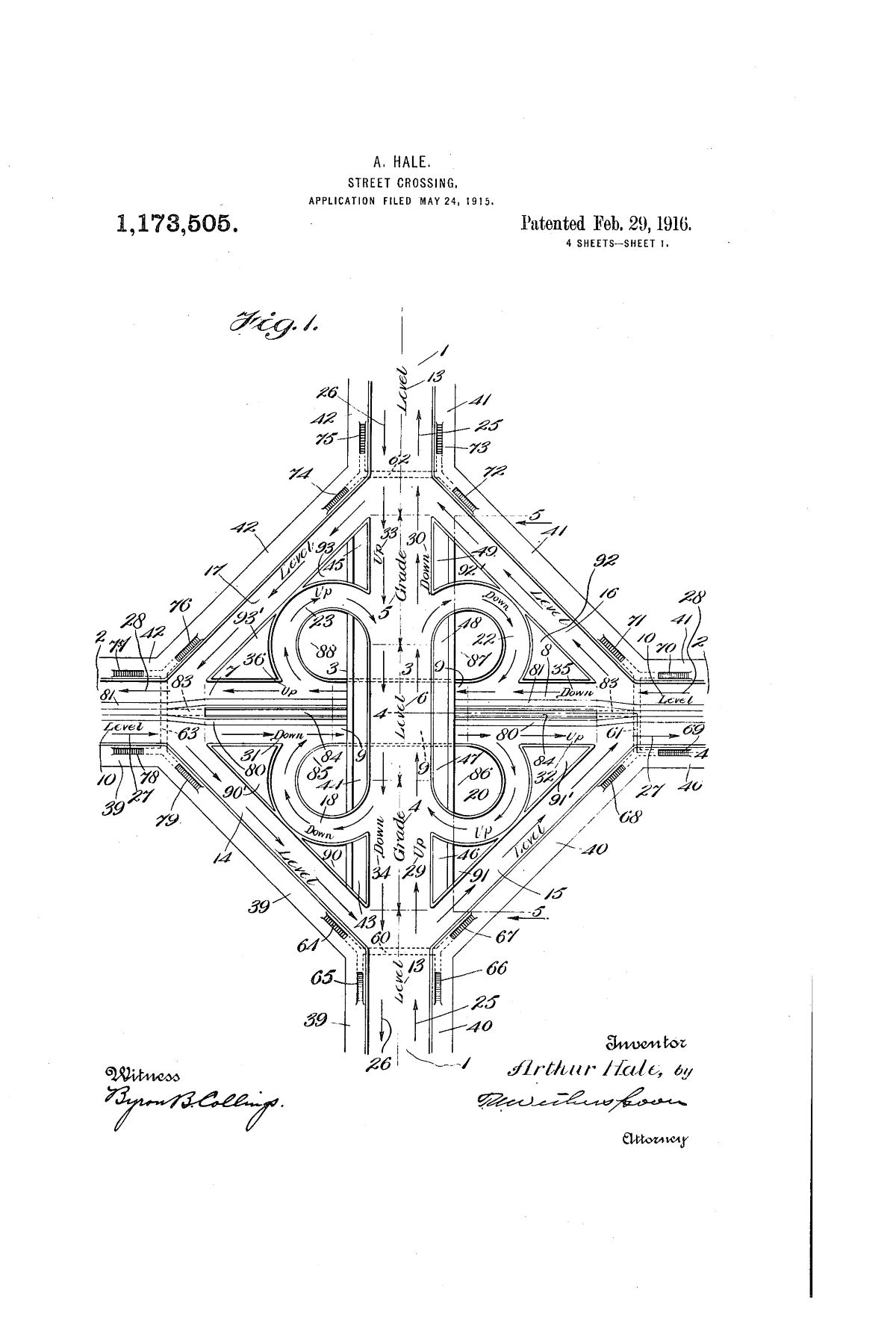May 24, 1915
Civil engineer Arthur Hale applied for a patent for his design of a road interchange focused on facilitating the flow of automobile traffic. Hale, who resided in the village of Rowlandsville in Maryland, characterized this design as one that contained “certain new and useful improvements in street crossings.”
Hale’s proposed interchange consisted of four circular loops of roadway that — from a bird’s-eye view — collectively resembled the leaves of a clover. As envisioned by Hale, these loops would allow drivers to connect to the overpass and underpass in each direction on both roads at an intersection.
Just a little over nine months after submitting his proposal for a grade-separated road junction, Hale was granted U.S. Patent 1,173,505 for what has become widely known as the “cloverleaf interchange.” This patent made Hale’s idea the first official design for road interchanges for automobiles in the United States.
It was not until 1929, however, that the first cloverleaf interchange in the United States was actually installed. This infrastructure was located in Woodbridge Township, New Jersey, specifically at the intersection of New Jersey Route 25 (since renamed U.S. Route 1/9) and New Jersey Route 4 (now part of New Jersey Route 35). That first-of-a-kind cloverleaf interchange was based on Hale’s patent and designed by Edward Delano of the Pennsylvania-based engineering firm of Rudolph & Delano.
The reason for constructing this interchange in the Garden State involved the steadily expanding number of automobiles in that region of the United States during the late 1920s. By that point in time, the traffic density in New Jersey was seven times the national average (or nearly 60,000 vehicles per day). This high volume was due in large part to drivers traveling between New York City and Philadelphia on a regular basis.
Not long after the debut of Woodbridge Township’s pioneering cloverleaf interchange, this road feature progressively grew in popularity and similar designs were eventually translated into full-fledged reality nationwide. A major appeal of this interchange was that a driver could travel from one road to another without stopping and also without needing to make a turn across the path of oncoming traffic.
Over time, though, the cloverleaf interchange a devised by Hale was seen as increasingly obsolete. This was because its disadvantages became all the clearer with the ever-mushrooming amount of travel on the nation’s roads. With many more automobiles clogging up those intersections and fewer available traffic gaps there, for example, drivers found it a lot tougher than before to merge safely between roads. Another key consideration involved money and space. A typical cloverleaf design required a relatively large share of real estate for the loop ramps, something that proved to be easy to acquire when there was an abundance of cheap land. By the 1950s, however, such property had generally become more expensive to obtain.
These concerns and others inevitably led to the replacement of quite a few of the nation’s early cloverleaf interchanges with newer traffic engineering innovations for busy intersections. Even the cloverleaf interchange in Woodbridge Township was not exempt from this trend; it was demolished by the New Jersey Department of Transportation in 2006.
Hale’s proposed cloverleaf interchange, however, retains an honored place in the world of engineering. Above all else, his patent for this transportation infrastructure helped set the stage for interchange design becoming the formal discipline that it is today.
Image Credit: Public Domain
Arthur Hale’s patent for the cloverleaf interchange is available in its entirety at https://patents.google.com/patent/US1173505A/en


Leave a comment